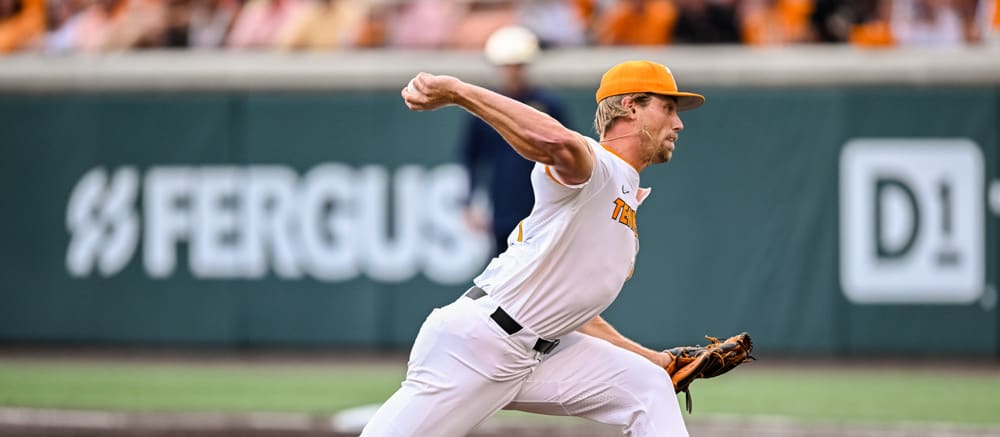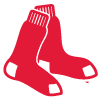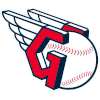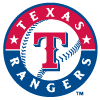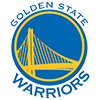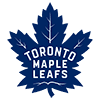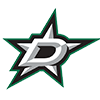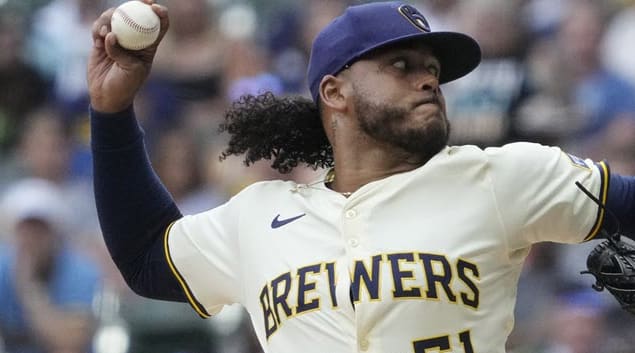This is my 11th year ranking prospects for fantasy, and I'd guess I've ranked fewer than 20 true relief pitchers on the top 400 prospect rankings (the first couple years it was just a top 200). Relievers have always been a de-emphasized area of the prospect landscape.
It's understandable why saves are the least relevant of the 10 standard roto categories when assembling a set of prospect rankings for fantasy. I don't even like ranking good starting pitching prospects higher than I think I need to, and I'm not alone. So focusing on pitching prospects who probably won't start or already don't start is admittedly a hustle with a low-percentage payoff.
Over the last five seasons, here is the saves leaderboard along with each pitcher's career minor-league stats:
| Closer | Handed | MLB Saves | MiLB Starts | MiLB Saves | MiLB K/9 |
1 | Kenley Jansen | R | 161 | 7 | 8 | 15.2 |
2 | Edwin Diaz | R | 153 | 71 | 1 | 9.5 |
3 | Josh Hader | L | 132 | 95 | 5 | 10.1 |
4 | Raisel Iglesias | R | 123 | 8 | 0 | 6.9 |
5 | Liam Hendriks | R | 114 | 120 | 6 | 7.9 |
6 | Aroldis Chapman | L | 111 | 20 | 8 | 12.3 |
7 | Brad Hand | L | 108 | 132 | 0 | 8.3 |
8 | Craig Kimbrel | R | 103 | 2 | 51 | 14.3 |
9 | Will Smith | L | 80 | 112 | 4 | 7.7 |
10 | Mark Melancon | R | 83 | 4 | 26 | 9.0 |
Closers can come from anywhere. Velocity, strikeouts and groundballs are the top things I look for, but there is no magic formula for pinpointing prospects who will eventually rack up saves.
This is my 11th year ranking prospects for fantasy, and I'd guess I've ranked fewer than 20 true relief pitchers on the top 400 prospect rankings (the first couple years it was just a top 200). Relievers have always been a de-emphasized area of the prospect landscape.
It's understandable why saves are the least relevant of the 10 standard roto categories when assembling a set of prospect rankings for fantasy. I don't even like ranking good starting pitching prospects higher than I think I need to, and I'm not alone. So focusing on pitching prospects who probably won't start or already don't start is admittedly a hustle with a low-percentage payoff.
Over the last five seasons, here is the saves leaderboard along with each pitcher's career minor-league stats:
| Closer | Handed | MLB Saves | MiLB Starts | MiLB Saves | MiLB K/9 |
1 | Kenley Jansen | R | 161 | 7 | 8 | 15.2 |
2 | Edwin Diaz | R | 153 | 71 | 1 | 9.5 |
3 | Josh Hader | L | 132 | 95 | 5 | 10.1 |
4 | Raisel Iglesias | R | 123 | 8 | 0 | 6.9 |
5 | Liam Hendriks | R | 114 | 120 | 6 | 7.9 |
6 | Aroldis Chapman | L | 111 | 20 | 8 | 12.3 |
7 | Brad Hand | L | 108 | 132 | 0 | 8.3 |
8 | Craig Kimbrel | R | 103 | 2 | 51 | 14.3 |
9 | Will Smith | L | 80 | 112 | 4 | 7.7 |
10 | Mark Melancon | R | 83 | 4 | 26 | 9.0 |
Closers can come from anywhere. Velocity, strikeouts and groundballs are the top things I look for, but there is no magic formula for pinpointing prospects who will eventually rack up saves. Perhaps the challenge alone is why we (the fantasy prospect ranking community) have spent such little time on it.
I'm old enough to remember when Matthew Berry had a fantasy baseball podcast, and one of the first phrases I associated with the game was his "never pay for saves" refrain. The game is very different than it was back then, but you still don't need to pay up for saves. You can give yourself a better chance of getting the saves you want if you pay up, but there's an opportunity cost to doing so, both in redraft and in dynasty. Projecting months and years ahead and trying to figure out which pitchers who have never closed before in the majors will be tasked with protecting small leads in the ninth inning is like trying to find a needle in a haystack, so why bother?
Josh Hader, Edwin Diaz and Emmanuel Clase are three of the best free/cheap dynasty pickups of the last decade, and they remain in extremely high demand in every league. If you picked one of them up before they were established closers and held on to them long enough, you were probably nodding and grinning while I was talking about not paying for saves. We all try to find the next great young closer in our dynasty leagues and in our redraft prep, but many of us probably don't try hard enough if we're striving to avoid paying a hefty price for our saves. I've opted to pay up in drafts for saves more often than not in recent years because I don't trust myself to find all the saves I need on the cheap.
I will probably always try to pay up for at least one closer in redraft, but in dynasty, I'd like to think I can find the next 2015 Hader, 2015 Diaz or 2019 Clase if I put in the time. To that end, I put together five groups of pitchers who I think are worth tracking going forward while hunting not for just saves, but high-impact saves, i.e. a closer who is also a big help in ratios and strikeouts.
Some of you probably don't play in deep enough leagues for this article to be actionable. But I hope there are more uses for this research than immediate add/drops, trade proposals or FYPD selections. Maybe you're planning on checking out some live minor-league baseball this year and you want to know which relievers to pay attention to. Maybe you're a fan and want to know which pitchers are on the way to help out your favorite team's bullpen. I know I plan to keep referring to these lists throughout the season as players climb the ladder so I can try to spot a reliever who may be pitching his way closer to MLB high-leverage duty.
This is my first attempt to fully scour this niche market (relief prospects) within a niche hobby (fantasy baseball). I've spent more time in the past couple weeks researching relief prospects than I have in the past few years combined. However, given how many minor-league relievers and starters who will turn into relievers are out there, I'm sure there are pitchers I should have included and didn't. In most cases where I felt we were at least a few years away from the team moving the pitcher to the bullpen, I omitted them, as that's too long to wait on most players, let alone potential relievers. Feel free to send me a message in the comments, on Twitter or on Discord if I omitted one of your favorite relief prospects.
Here are the five types of potential closers I looked for:
- MiLB relievers
- MiLB starters who will soon transition to relief
- MiLB starters who are more likely to end up as relievers than starters long term
- MiLB starters who are more likely to start than relieve, but who have a flaw or two that could lead to them moving to the bullpen long term
- Pre-prime MLB relievers who are not listed by our relief pitching expert Ryan Rufe as their team's closer or as a top-20 closer in waiting
Within each group, I ranked the pitchers based on how likely I think it is that they will turn into a valuable fantasy reliever. For the pitchers in the middle three groups who are still being developed as starters, I include the reasons they may move to the bullpen in parenthesis. Obviously a big aspect of landing a future closer is team context. Good relief prospects on teams with shallow bullpens are more intriguing than good relief prospects on teams like Seattle or Cleveland, where there are already young, overqualified setup men in the big-league bullpen.
MiLB Relievers
1. Ben Joyce, R, LAA
The Angels gave Joyce a hair under $1 million last year as a reliever-only prospect out of Tennessee. He's already a Pitching Ninja legend thanks to his triple-digit heater that has touched 105 mph. Joyce's slider and command/control lag behind his fastball, but he still had success in 13 appearances at Double-A after signing, and there's a pretty clear path for him to be pitching near the back of the Angels' bullpen this year or next. Joyce already had Tommy John surgery in 2021.
2. Colby White, R, TB
White may have spent a good chunk of last season getting high-leverage outs for the Rays, but he needed Tommy John surgery in April. White has a multi-year track record of closing games with his 70-grade fastball and 60-grade slider. His profile is arguably the most closer-like of any minor-league reliever, but we still need to see him make a full return and his team context isn't ideal, as the Rays never seem to have a shortage of quality late-inning arms.
3. Justin Martinez, R, ARI
Martinez has only notched two career minor-league saves, and he walked 12 batters in 16.2 innings across Double-A, Triple-A and the Arizona Fall League last season, but he was nonetheless protected from the Rule 5 draft. The 6-foot-3 righty had Tommy John surgery in 2021, so hopefully his control will be better in his first full year back. He can touch triple digits with his fastball and compliments it with a filthy splitter and an above-average slider. Arizona's ninth inning is wide open long term, and Martinez is knocking on the door.
4. Zach Brzykcy, R, WAS
Brzykcy dominated across the three highest levels of the minors last season, logging 14 saves and 95 strikeouts in 61.1 innings. He spent the majority of his season at Double-A. The 6-foot-2, 230-pound righty has an impressive track record, getting named Cape Cod League reliever of the year in 2019. His upper-90s fastball has elite movement, and his curveball projects as an above-average second pitch. The Nationals have other young hurlers who could ascend to the closer role in the coming years — I like Hunter Harvey, whom Rufe ranked as the 12th-best closer in waiting — but if a minor leaguer ends up getting that job, Brzykcy seems like the best bet.
5. Carlos Vargas, R, ARI
The Guardians' 40-man roster is perpetually in crunch mode, and Vargas was shipped to Arizona in November to clear a spot. It was a great move for Vargas' chances of eventually getting high-leverage work. He had Tommy John surgery in 2020 and returned to log 34.1 innings in the upper levels last season. Vargas' control would be what prohibits him from getting save chances, but if he can throw more consistent strikes, his mid-to-upper-90s fastball and plus-plus slider would allow him to dominate.
6. Abner Uribe, R, MIL
It still seems like a matter of when, not if, Uribe needs Tommy John surgery, as youngsters who touch 103 mph almost always seem to need the procedure at some point. He missed most of last season due to knee surgery, but was able to pitch in the Arizona Fall League and got added to the Brewers' 40-man roster as Rule 5 draft protection. Uribe will work on improving his strike-throwing and his slider this season in the upper levels of the minors. If the team opts to cash out Devin Williams in a year or two, Uribe has the ceiling to be the next great Brewers closer, but he's not a finished product.
7. Colin Selby, R, PIT
Already on the 40-man roster and with Tommy John surgery completed in 2020, Selby is ready to make his big-league debut this season. His upper-90s fastball, wipeout slider and plus low-80s curveball fit perfectly in a high-leverage role (eight saves in 32.2 innings at Double-A last year), but his command is currently more that of a setup man. If he can take a step forward in that regard, Selby could step into the ninth inning if/when David Bednar gets traded to a contender.
8. Hagen Danner, R, TOR
A former catcher, Danner has only been a full-time reliever for a few years, and in that time he's been limited by the pandemic and a shoulder injury in 2022. He has ninth-inning stuff when healthy and was able to get back in action during the Arizona Fall League, where he touched 99 mph with excellent movement. The biggest risk factor with Danner is his durability, but he could also stand to improve his strike-throwing this year in the upper levels of the minors. He is already on the 40-man roster.
9. Andrew Moore, R, CIN
The third or fourth returning piece (depending on how you value back-end starter/swingman Levi Stoudt) in the Luis Castillo trade, Moore sat in the upper-90s with his fastball last season and features one of the best curveballs among minor-league relievers. His main flaws are shaky command and control plus a more distant ETA (sometime in 2024 if he has a strong 2023), but it wouldn't be surprising if Moore was working the eighth or ninth inning for the Reds later this decade.
10. Franklin Sanchez, R, MIA
Sent from the Mets to the Marlins in the deal that sent Elieser Hernandez and Jeff Brigham to New York, Sanchez was touching triple digits with his fastball in the Arizona Fall League and also features a devastating low-90s slider. He is more of a 2024 option for Miami, and improved command/control will be necessary for him to reach his ceiling, but Sanchez has the pure stuff to handle the ninth inning and may even add more velocity as he continues to fill out his 6-foot-6 frame.
11. Carson Coleman, R, NYY
This 24-year-old righty logged 19 saves with a 95:19 K:BB in 63.1 innings last season across High-A and Double-A. His 57.1 GB% at High-A was excellent, but it fell to 34.8 percent at Double-A, where he hit 10 batters in 35 appearances. He gave up just 37 hits and three homers on the season, as minor leaguers couldn't touch his rise-and-run mid-90s fastball. Coleman also adds deception with his lower arm slot. He needs to slightly improve his control and low-80s slider to really look like a traditional closer.
12. Evan Reifert, R, TB
Reifert's statistical case to be a future closer is among the most compelling on this list. He struck out 87 batters in 49 innings across complex ball, High-A, Double-A and the Arizona Fall League last season. His run in the AFL was particularly impressive after he struggled early in the year at Double-A. Reifert's slider is a monster and his fastball sits in the mid-90s, but his control and command may fit better in the seventh and eighth innings.
13. Ricky Karcher, R, CIN
Karcher, a 25-year-old righty, was added to Cincinnati's 40-man roster after notching 10 saves across Double-A and Triple-A last season. His plus fastball and plus slider give him as good of a two-pitch recipe as any Reds reliever, but he has struggled to harness his control. Karcher should spend most of the year in the majors, so we should track his strike-throwing early in the year to see if it's realistic to expect him to pitch his way into the late innings as a rookie.
| 14 | Tim Herrin CLE |
| 15 | Andrew Baker PHI |
| 16 | Sean Reynolds MIA |
| 17 | Steven Cruz KC |
| 18 | Justin Yeager MIL |
| 19 | Freddy Pacheco STL |
| 20 | Cam Robinson MIL |
| 21 | Christian Montes De Oca ARI |
| 22 | Victor Vodnik ATL |
| 23 | Guillermo Zuniga STL |
| 24 | Nick Avila CHW |
| 25 | Tommy McCollum PHI |
| 26 | Ronan Kopp LAD |
| 27 | Garrett Acton OAK |
| 28 | Isaiah Campbell SEA |
| 29 | Jose Cruz SF |
| 30 | Ricky DeVito PIT |
| 31 | Jose Ferrer WAS |
| 32 | Kolton Ingram LAA |
| 33 | Eric Torres LAA |
| 34 | R.J. Dabovich SF |
| 35 | Conor Grammes ARI |
| 36 | Orion Kerkering PHI |
| 37 | Brooks Wilson ATL |
| 38 | Marc Church TEX |
| 39 | Erik Miller SF |
| 40 | Gerardo Carrillo WAS |
| 41 | Xavier Moore BAL |
| 42 | Nic Enright MIA |
| 43 | Francisco Morales PHI |
| 44 | Hayden Birdsong SF |
Move To Relief Imminent
1. Luis Gil, R, NYY (third pitch, control, durability)
For years, Gil's fastball has been one of the best heaters in the minors. He needed Tommy John surgery in May 2022 and won't return until this summer. It would be understandable for the Yankees to attempt to build Gil back up to develop him as a starter, especially after seeing how a pitcher with similar pitch characteristics, Spencer Strider, dominated last season. However, it would be a safer bet to just get his electric arm into the big-league bullpen once he knocks off the rust.
2. Luis Medina, R, OAK (control)
Many of us have been dreaming about Medina's upside as a closer for four years, and he's still been on a strict starter's track. That should change in 2023, however, as this is Medina's final year with a minor-league option and he doesn't appear close to fixing his control issues to the point that he could start. His upper-90s fastball is a monster pitch that could maybe sit in the triple digits in relief, and his curveball and changeup can be plus pitches when he's on. The A's won't win many games, but there's a clear path to the ninth inning for Medina.
3. Griff McGarry, R, PHI (control)
Evaluators understandably fall in love with McGarry's deep, disgusting repertoire (at least three plus pitches), but it feels like wish-casting to project anything other than an eventual home in the bullpen. If he doesn't take a step forward as a strike-thrower this year (14.6 BB% last season), I'd expect the Phillies to explore cashing him out at the 2023 trade deadline as they attempt to make another push.
4. Connor Phillips, R, CIN (control)
One knock on Moore and Karcher in the previous group is that Phillips is also in the organization and has even better pure stuff (mid-to-upper 90s fastball, plus slider, above-average curveball). With Cincinnati in the midst of a rebuild, they'll probably keep Phillips on a starter's track early this season, but his control is so bad that I'd be hoping he gets moved to the bullpen if I were rostering him in dynasty.
5. Sam Bachman, R, LAA (third pitch, durability, control)
Prior to Bachman's draft, my comp for him was Craig Kimbrel because of his delivery and deadly fastball/slider combination. The stuff has been inconsistent since he got into pro ball, but his mid-90s fastball with heavy run and his upper-80s slider still project as plus pitches. As is often the case, the team that acquires a player is usually the last to admit that player won't make it as a starter, so I don't see the Angels moving Bachman to the big-league bullpen early this season, but it still seems like an inevitability. It's a race between Bachman and Joyce for who can secure the Angels' closer role first.
6. Yosver Zulueta, R, TOR (control, third pitch)
I know that Toronto will deploy Zulueta as a starter again this season, but I think it's more likely that he eventually provides significant fantasy value as a reliever than as a high-WHIP starter. His control is easily his worst tool, but it's not so bad that he couldn't ride his upper-90s fastball and plus slider to success in high-leverage work. Jordan Romano's existence (and Nate Pearson already being converted to relief) limit Zulueta's short-term potential.
7. Seth Johnson, R, BAL (durability, third pitch)
It's a testament to how much Baltimore likes Johnson's arm that they traded for him (in the three-teamer that sent Trey Mancini to Houston and Jose Siri to Tampa Bay) and protected him from the Rule 5 draft despite the fact he needed Tommy John surgery in August 2022. The former Rays farmhand and former position player boasts a mid-90s fastball with good hop and a plus slider. Given that Johnson turns 25 in September and has never pitched above High-A, it makes sense to me to fast-track him as a reliever, but Baltimore will probably give him one more shot to make it as a starter.
8. Matt Canterino, R, MIN (durability, control)
Like Johnson, Canterino had Tommy John surgery in August of last year. He might not get back into game action until after his 26th birthday in December 2023 and he walked 15.3 percent of batters last year at Double-A, so I think the Twins should bring him back as a multi-inning reliever. Canterino has three plus pitches and a 41.9 K% across High-A and Double-A, so he might even miss enough bats to provide fantasy value without getting regular save opportunities.
9. Sixto Sanchez, R, MIA (durability)
If Sanchez's velocity can at least make it all the way back, he could still provide value out of the bullpen. Given how much time he has missed (he hasn't pitched since 2020), it would make sense to ease him back in relief, and if he has success in the bullpen, maybe he just stays there long term.
10. Kumar Rocker, R, TEX (durability, third pitch)
Rocker may never even make it to the majors if his arm/shoulder doesn't hold up, but given the Rangers' investment in him ($5.2 million), I could see them pigeonholing him as the closer to try to justify that pick. At his best, Rocker's slider and fastball are good enough for him to have success in the ninth inning, but it's a big question as to whether that pitcher is still there after his brutal Arizona Fall League showing.
11. Nick Frasso, R, LAD (durability, third pitch, control)
One of the most eye-popping stats I found during my outlook-writing process this winter was the fact that Frasso hasn't thrown more than 60 innings in a season dating all the way back to when he was a freshman at Loyola Marymount in 2018. The gangly 6-foot-5 righty has a plus-plus fastball that touches triple digits, but he's still working on refining his secondaries. The Dodgers clearly targeted him in the trade that sent Mitch White to Toronto, but I think even they know that the likelihood of him remaining a starter is slim.
12. Asa Lacy, L, KC (control, durability)
Lacy walked 42 batters and hit another 13 in 28 innings across complex ball and Double-A last year, so the only thing keeping him on a starter's track is his pedigree (fourth-overall pick in 2020) and Kansas City's investment in him. Reports differ on whether Lacy's slider or changeup is his best secondary at this point, but both have plus potential and his fastball was still scraping the upper 90s last season.
13. Ryan Cusick, R, OAK (third pitch, control, durability)
Even when Atlanta took Cusick with the 24th overall pick in 2021, the scouting report screamed future reliever, as he was mostly a two-pitch guy with shaky command and control. The only significant change since then is that durability concerns are also present. Oakland has a lot of these guys (starters who will probably need to move to the bullpen), so the competition for saves in that bullpen in 2024 and 2025 could be steep.
| 14 | Austin Vernon TB (control) |
| 15 | Clayton Beeter NYY (third pitch, control) |
| 16 | Casey Legumina CIN (control) |
| 17 | Cody Bolton PIT (durability, control) |
| 18 | Zak Kent TEX (third pitch, control) |
| 19 | Randy Vasquez NYY (third pitch, control) |
| 20 | Jorge Juan OAK (durability, third pitch, control) |
| 21 | Joel Ibarra LAD (control) |
| 22 | Jackson Rutledge WAS (durability, control) |
| 23 | Misael Tamarez HOU (control) |
| 24 | Christian McGowan PHI (control, durability) |
| 25 | Carlos Duran LAD (durability, third pitch, control) |
| 26 | Kyle Nicolas PIT (control) |
| 27 | Joe Boyle CIN (control) |
| 28 | Kyle Hurt LAD (control, third pitch) |
| 29 | Jaime Melendez HOU (third pitch, control) |
| 30 | Carlos Jimenez PIT (control) |
| 31 | Joseph Hernandez MIL (control, third pitch) |
| 32 | Yoniel Curet TB (control, third pitch) |
| 33 | Bryce Bonnin CIN (durability, control, third pitch) |
| 34 | Beck Way KC (third pitch, control) |
| 35 | DJ Herz CHC (control) |
| 36 | Hayden Juenger TOR (third pitch, control) |
| 37 | Junior Santos NYM (control, third pitch) |
| 38 | Ian Seymour TB (third pitch, durability, control) |
| 39 | Trent Palmer TOR (durability, control) |
More Likely To Relieve
1. Emmet Sheehan, R, LAD (control, third pitch)
Imagine Joe Ryan's fastball but instead of averaging 92 mph, it averages 96 mph. That's what Sheehan brings to the table, albeit without Ryan's command. It's unclear whether Sheehan will throw enough strikes to start, and it's also unclear how much he needs in the way of quality secondary pitches (he already has a strong changeup) to turn big-league lineups over. Improving his command and control is probably more critical to him making it as a starter than significant gains with his secondaries. He'll probably get at least another full season to work as a starter, as he doesn't need to be added to the 40-man until after next season.
2. Daniel Palencia, R, CHC (durability, control, third pitch)
A 5-foot-11 righty whose fastball regularly gets to triple digits as a starter, Palencia's potential as a late-inning arm is obvious. He compliments his elite fastball with a plus slider and useable changeup. The key will be for him to make it to the majors without dealing with any significant arm injuries that typically befall young pitchers who throw this hard. If he can stay healthy this year, he should debut in 2024.
3. Prelander Berroa, R, SEA (control, third pitch)
There's a reason Berroa is already with his third organization. Teams salivate over his lethal fastball/slider combination and then sour on him after being unable to coax out more starter traits (command, changeup). He is now on the 40-man roster and inching closer to his big-league debut. Berroa gave up more walks (63) than hits (54) in his 100.2 innings last season, and the inability to cut down on the free passes may actually be more prohibitive than his lack of a quality third pitch. Unfortunately, this bullpen already has plenty of ninth-inning caliber arms.
4. Freddy Tarnok, R, OAK (third pitch, control)
One of about a half dozen recently acquired A's pitching prospects who may struggle to stick as a starter, Tarnok is ready to be tested with close to a full season in the majors. His fastball touches 98 mph and his upper-70s curveball can be a true hammer when he's on. Tarnok's command and third pitch still lag behind, and while he could be Oakland's best reliever in the short term, there's no reason for them to pull the plug on him as a starter just yet.
5. Cole Wilcox, R, TB (durability, third pitch)
It seems like Wilcox, who returned last year from Tommy John surgery, has the command to start. However, given that he turns 24 this season and hasn't pitched above Single-A, it makes sense to me to eventually fast-track him to the bullpen, barring a strong run through the minors as a starter this year. He could be a dominant fastball/slider closer, thanks to his elite groundball tendencies and above-average command.
6. Emiliano Teodo, R, TEX (control, third pitch)
A former position player who can already touch 101 mph with his heater, Teodo looks like a future high-leverage reliever on paper, but Texas will keep him on a starter's track for at least the 2023 season. Teodo touches 94 mph with his slider, so the pitches are there for him to close, he just needs to have good enough command for the ninth inning and the Rangers need to not drag their feet with the decision to send him to the bullpen.
7. Royber Salinas, R, OAK (control)
Another recently acquired Athletics pitching prospect who faces an uphill climb to make it as a big-league starter, Salinas has upwards of three plus pitches and below-average command/control. He also has a body that more closely resembles past relievers than successful big-league starters — although every now and then we get a Carlos Zambrano type who is the exception to the rule.
8. Ryan Pepiot, R, LAD (control)
As a flyball pitcher whose control is below-average, Pepiot may fit better as a multi-inning reliever than as a closer for one of the best teams in baseball. Despite the quality of his stuff, I expect the Dodgers to transition him away from starting in the coming months, especially with better starting pitchers (Gavin Stone, Bobby Miller) coming up through the system behind him.
9. Landon Sims, R, ARI (durability, third pitch)
On paper, Sims is a prototypical closer, armed with a dominant fastball/slider combination and a bulldog mentality. However, the Diamondbacks probably didn't take him with the 34th overall pick to fast-track him to the big-league bullpen. Sims is still recovering from Tommy John surgery, but when he returns this summer, the expectation is that Arizona will develop him as a starter.
10. Jacob Misiorowski, R, MIL (control, third pitch)
Like with Sims, Misiorowski's potential in the bullpen is obvious, but his team invested seven figures in him in last year's draft with the hopes of developing a high-strikeout starter. It's possible Misiorowski's command and control will be Asa Lacy level bad and it will be clear early on that the bullpen is a better avenue to extract value.
11. Jared Jones, R, PIT (control)
Even entering the 2020 draft, it seemed clear to me that Jones' most likely route to fantasy relevance was as a high-leverage reliever due to his poor command. That outlook remains true, as Jones still touches triple digits with his fastball and compliments it with a couple good breaking balls. Unfortunately, we might be a year or two away from the Pirates pulling the plug on him as a starter.
| 12 | Chayce McDermott BAL (control) |
| 13 | Porter Hodge CHC (third pitch, control) |
| 14 | Miguel Ullola HOU (control, third pitch) |
| 15 | Ben Brown CHC (control, durability) |
| 16 | AJ Smith-Shawver ATL (control) |
| 17 | Bryan Mata BOS (control) |
| 18 | Mike Baumann BAL (third pitch, control) |
| 19 | Nick Nastrini LAD (control) |
| 20 | Spencer Arrighetti HOU (control) |
| 21 | Mason Black SF (third pitch) |
| 22 | Norge Vera CHW (durability, control, third pitch) |
| 23 | William Kempner SF (control, third pitch) |
| 24 | Walbert Urena LAA (control, third pitch) |
| 25 | Jaydenn Estanista PHI (control, third pitch) |
| 26 | Cole Henry WAS (durability) |
| 27 | Jared Kelley CHW (control) |
| 28 | J.T. Ginn OAK (durability) |
| 29 | Wikelman Gonzalez BOS (control) |
| 30 | Dahian Santos TOR (control) |
| 31 | Davis Sharpe CLE (third pitch, durability) |
| 32 | Jairo Iriarte SD (control) |
| 33 | Reggie Crawford SF (durability, control, third pitch) |
| 34 | Peyton Pallette CHW (durability) |
| 35 | Blade Tidwell NYM (third pitch, durability) |
| 36 | Tanner Burns CLE (durability, control) |
| 37 | Adam Macko TOR (durability, control) |
| 38 | Thad Ward WAS (third pitch, control, durability) |
| 39 | Calvin Ziegler NYM (third pitch, control) |
| 40 | Keaton Winn SF (third pitch) |
| 41 | Garrett Hawkins (third pitch, control) |
| 42 | CJ Van Eyk TOR (control, durability) |
| 43 | Dax Fulton MIA (third pitch) |
| 44 | Forrest Whitley HOU (control, durability) |
| 45 | Andry Lara WAS (third pitch, control) |
More Likely To Start
1. Max Meyer, R, MIA (durability)
If I rostered Meyer in a roto dynasty league, I'd rather Miami just peg him as the long-term closer than continue developing him as a starter when he comes back from Tommy John surgery. This won't happen, but I'm making a point about the likelihood of different outcomes. Premium young closers are much more scarce than potential mid-rotation starters. This isn't a Shane Baz scenario, where the pitcher had the skills to be a dominant starter at the time of the torn UCL. Meyer's changeup is improved, but he was still developing that offering when he got injured and he's never shown he can handle a true starter's workload.
2. Drey Jameson, R, ARI (third pitch)
As an undersized yet hard-throwing righty with a wipeout slider, Jameson has the look of a future closer, but I still believe in him as a starter, as do the Diamondbacks. However, he still needs a reliable weapon against lefties, and if he can't develop one, we could see Arizona move him to the bullpen, where there is currently a long-term vacancy in the ninth inning.
3. Mason Miller, R, OAK (durability)
Miller is one of Oakland's best pitching prospects, so they will surely exhaust all efforts to turn him into a quality big-league starter. That said, he turns 25 in August and has logged just 36.2 pro innings including the Arizona Fall League, so the clock is really ticking. The fact that he could be an effective big-league closer right now (he might sit 100 mph with his fastball as a reliever with a wipeout slider) and has such little experience as a pro starter is relevant.
4. Taj Bradley, R, TB (third pitch)
Bradley could be a dominant closer as is, but the Rays will surely work to develop him into a good starter, which is a potential outcome if his curveball or changeup improves. He currently touches 98 mph with excellent life and could be a triple-digit offering in short relief stints, while his hard cutter would also play up even more out of the bullpen. Given where he is developmentally, we could even see Bradley used as a postseason relief weapon this season.
5. Luis Ortiz, R, PIT (control, third pitch)
Ortiz's top two pitches (fastball, slider) are so good that he might already be as good as David Bednar if he were to be moved to the bullpen, but obviously the Pirates desperately need to develop starting pitching and Ortiz has already had brief MLB success in that role. Maybe if his command and control are really poor this season the team might explore moving him to the bullpen, which might also coincide with Bednar getting dealt.
| 6 | DL Hall BAL (control, durability) |
| 7 | Mike Burrows PIT (durability) |
| 8 | Daniel Espino CLE (durability) |
| 9 | Reese Olson DET (control) |
| 10 | Bryce Miller SEA (third pitch, control) |
| 11 | Cade Horton CHC (third pitch, durability) |
| 12 | Jarlin Susana WAS (third pitch, control) |
| 13 | Owen White TEX (durability) |
| 14 | Bubba Chandler PIT (control) |
| 15 | Cody Morris CLE (durability) |
| 16 | Matt Allan NYM (durability) |
| 17 | River Ryan LAD (durability, control) |
| 18 | Noah Denoyer BAL (durability, third pitch) |
| 19 | Landen Roupp SF (third pitch) |
| 20 | Jake Eder MIA (third pitch, durability) |
| 21 | Gunnar Hoglund OAK (durability) |
| 22 | Will Warren NYY (third pitch, control) |
MLB Relievers
This is not an exhaustive list of every pre-prime MLB reliever, but it's a collection of relievers with MLB experience who peak my interest to some extent. I'm sure many of you have a reliever or two you're keeping an eye on who is under the radar and not listed here. Feel free to make your nominations in the comments. I may have omitted someone I shouldn't have, but again, I didn't include any current closers or anyone from Ryan Rufe's top 20 closers in waiting list.
Of the players on that list, Robert Suarez, Hunter Harvey, Reynaldo Lopez are my favorite targets in dynasty leagues. As a quick aside, Lopez is a great example of the difficulty in pinpointing pitching prospects who could move to the late innings, as I've wanted Lopez to be a reliever since he was still in the minors with the Nationals in 2016 and it took until 2022 for him to finally be relegated to permanent relief duty after he racked up a 4.73 career ERA in 515.1 MLB innings as a starter.
| 1 | Nate Pearson TOR |
| 2 | Bryan Abreu HOU |
| 3 | Codi Heuer CHC |
| 4 | Chris Rodriguez LAA |
| 5 | Keegan Thompson CHC |
| 6 | Joe Jimenez ATL |
| 7 | Cole Waites SF |
| 8 | Dylan Coleman KC |
| 9 | Trevor Stephan CLE |
| 10 | Gavin Hollowell COL |
| 11 | Adbert Alzolay CHC |
| 12 | Jose Hernandez PIT |
| 13 | Ron Marinaccio NYY |
| 14 | Greg Weissert NYY |
| 15 | Zack Thompson STL |
| 16 | Jeremiah Estrada CHC |
| 17 | Gregory Santos CHW |


